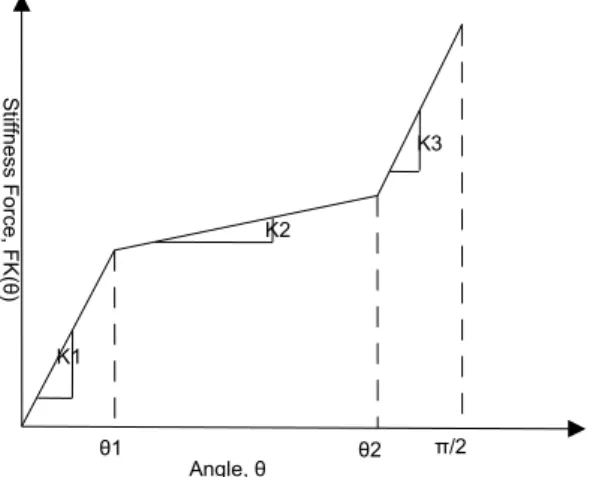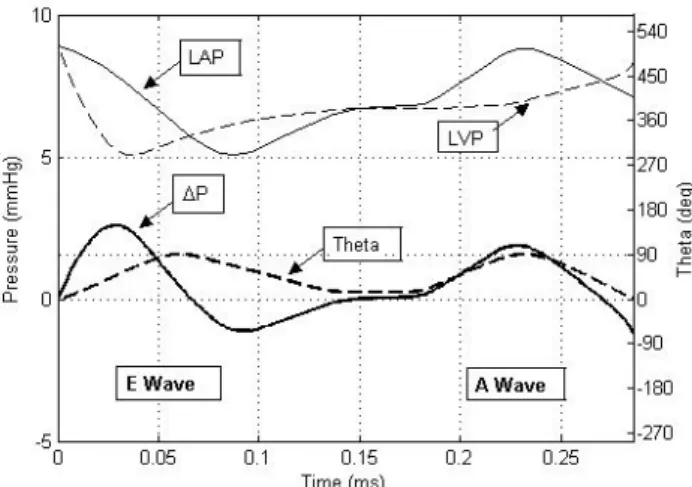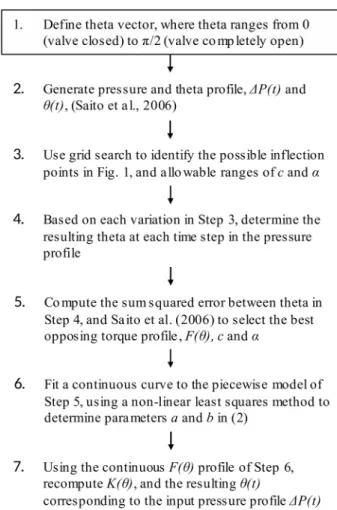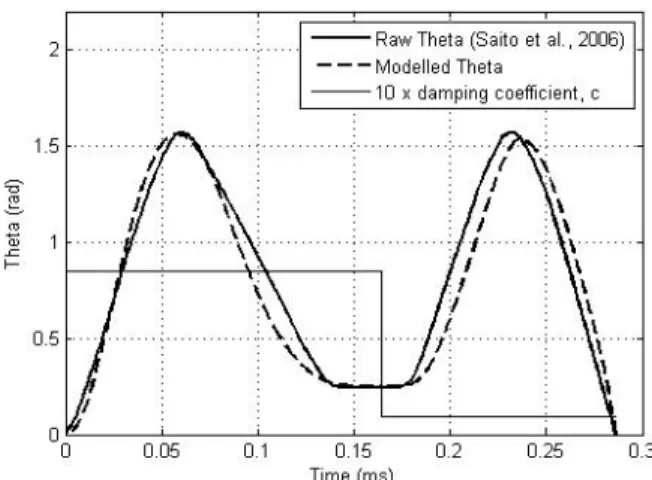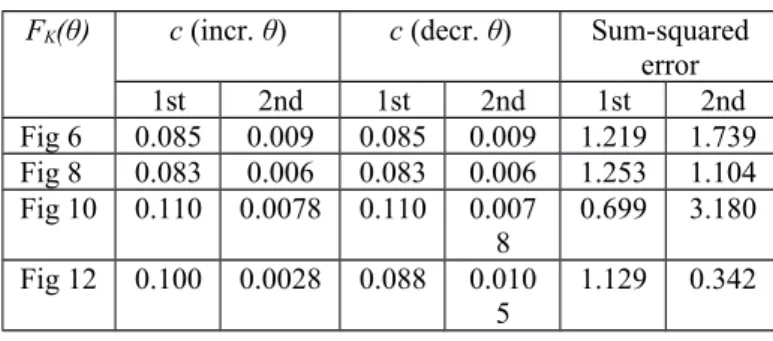A Simplified Rotation
al Spring Model for Mitral Valve Dynamics
K.T. Moorhead*, C.E. Hann**, J.G. Chase**, S. Paeme*, P. Kolh*, P.C. Dauby*, T. Desaive* * Cardiovascular Research Centre, University of Liege, Liege, Belgium (E-mail: kmoorhead@ulg.ac.be)** Department of Mechanical Engineering, Centre for Bio-Engineering, University of Canterbury, Christchurch, New Zealand Abstract: A simple non-linear rotational spring model has been implemented to model the motion of
mitral valve, located between the left atrium and ventricle. A measured pressure difference curve was used as the input into the model, which represents an applied torque to the valve chords. Various damping and hysteresis states were investigated to find a model that best matches reported animal data of chord movement during a heartbeat. The study is limited by the use of one dataset from the literature, however results clearly highlight some physiological issues such as the damping and chord stiffness changing within one cardiac cycle. Very good correlation was achieved between modeled and experimental valve angle, indicating good promise for future simulation of cardiac dysfunction, such as mitral regurgitation or stenosis.
Keywords: Cardiac cycle, mitral valve, non-linear rotational spring, damping, hysteresis
1. INTRODUCTION
Valvular dysfunction is a relatively common and costly heart disease, typically requiring mechanical valve replacement. It has two primary forms, stenosis and regurgitation. Mitral stenosis is the abnormal narrowing of the mitral valve, which slows blood flow and is the only heart disease that is caused predominately by rheumatic fever. Mitral stenosis accounts for 10% of single native valve diseases, (Iung et al., 2003). Mitral regurgitation is more common in the elderly and is the leaking of blood through the mitral valve from the left ventricle into the left atrium. Regurgitation occurs due to a dysfunction of the valve leaflets, papillary muscles or the chordae tendineae, and has an occurrence of 2%, (Jones et al., 2001).
The mitral valve separates the left atrium and ventricle. When functioning correctly, it allows blood to flow from the atrium to the ventricle during diastole, and prevents it flowing back during systole. For a normal mitral valve, about 70-80% of the blood flow occurs during the early filling phase of the left ventricle. After this phase, the left atrial contraction contributes approximately 20% more to the volume in the left ventricle prior to mitral valve closure and ventricular systole. Similar behaviour is seen in the right ventricle with the tricuspid valve. Abnormal dynamics in this filling phase in either ventricle may suggest valve dysfunction, but could also suggest a wider problem with the circulation, for example pulmonary embolism (Ristow et al., 2007). Pulmonary embolism is often characterised by tricuspid regurgitation and causes the secondary effect of increased volume in the atrium and/or ventricle, (Ristow et al., 2007). Thus, significant research concentrates on the understanding of detailed flow dynamics and pressure around the valves and atria.
This work was supported by the University of Liege, the University of Canterbury and the French Community of Belgium (Actions de Recherches Concertées Académie Wallonie-Europe)
Methods for measuring flow include Doppler echocardiography (Wilkins et al., 1986; Firstenberg et al., 2000), Cineangiography (Laniado et al., 1975), and cinefluro-scopy with radiopaque marker implantation (Pohost et al., 1975). All of these methods are either invasive or complex and time-consuming. Hence, none lend themselves to regular use for ongoing patient monitoring.
Another approach for characterising valvular dysfunction is through physical models, (Wright et al., 1997; Nordsletten et al., 2009), or more commonly fluid flow modelling around the valves. Flow around the valves can be turbulent and represent a highly non-linear system that is challenging to model. Current models of this type are usually based on Navier-Stokes, (Baccani et al., 2003), or more simplified models of Bernoulli flow, (Clark, 1975; Bellhouse, 1972). However, all of them require difficult to obtain detailed geometric information to construct, and are very difficult to validate. Thus, they too are not useful for patient-specific monitoring or diagnosis.
This research uses simple dynamic models of the stiffness of the valve leaflets to characterise the fundamental effects on flow and pressure, rather than concentrating on highly detailed fluid flow models. The valve is treated as a non-linear rotational spring or a ‘hinge’ with the change in angle under pressure driven flow being related to the stiffness and damping of the valve. Thus, the essential flow and pressure dynamics can potentially be used to back calculate the strength of the different chord structures in the valve, giving a physiological measure of valve disease with respect to the overall non-linear stiffness defined. This model and the methods developed are tested and compared with clinical data from literature for initial proof-of-concept validation.
K1 K2 K3 θ1 θ2 π/2 Angle, θ S tiff ne ss F or ce , F K (θ ) 2. METHODOLOGY 2.1 Generalised Model
The model treats the valve’s fundamental response to pressure as a non-linear rotational spring or a hinge with a stiffness force dependent on the angle.
Fig. 1. Force as a function of angle, representing three different stiffness profiles.
Fig. 1 shows a hypothetical case as a piecewise linear function. In the first section, 0<θ<θ1, the force changes
rapidly with a shape K1=FK(θ1)/ θ1, which corresponds to the
stiffness of the valve during this period. In the middle section, θ1<θ<θ2, the slope of the stiffness is much lower, and
in the final section, θ2<θ< π/2, the stiffness is high again. The FK(θ) curve in Fig. 1 could also be represented by many more
piecewise linear sections, which in the limit would define a continuous curve, with stiffness as a continuous function of θ defined:
K (θ )=dFK(θ )
dθ (1)
A continuous description of FK(θ) in Fig. 1 is
defined:
FK(θ )=a1+a2θ +a3e−b1θ+a 4e −b2θ (2)yielding K(θ):
K (θ )=dFK(θ ) dθ =a2−b1a3e −b1θ −b2a4e−b2θ (3) For example, substituting a1=-a3-a4, a2=0.04, a3=0.002, a4=-0.35, b1=-3.7, b2=11 into (2), yields the force versus θ curve
in Fig. 2. Note that in this case, the force dramatically increases for 0<θ<0.2, has a small slope for 0.2<θ<1, and increases more rapidly again for 1<θ<π/2 . It thus captures the fundamental behaviour of Fig.1. The corresponding stiffness, K(θ) from (3) is also shown in Fig. 2. Note that in
Figs. 1 and 2, the stiffness in the first and last sections are assumed higher than the middle section. This assumption was initially made from a thought experiment that the chords would stretch more at the beginning and end of the opening, similar to the elastic properties of blowing up a balloon. However this dynamic is shown not to be the case.
Fig. 2. Force as a function of angle (continuous curve) for a1=-a3-a4, a2=0.04, a3=0.002, a4=-0.35, b1=-3.7, b2=11, and corresponding stiffness profile.
In general, the FK(θ) curve of (2) and stiffness of (1) and (3)
could be used to describe the physiological and mechanical behaviour of the valve as a function of the angle. This behaviour can then be physiologically related to the anatomical chord structures and how they are utilised during a heartbeat.
However, to have a complete model or simulate this behaviour, the input driving force that opens and closes the valve must be included. For the mitral valve, this input force arises from the difference in pressure ΔP(t) between the left ventricle and the left atrium.
A rotational spring mass damper model is defined:
I ¨θ+ c ˙θ+FK(θ )=αΔP(t ) (4)
ΔP (t )=LAP(t )−LVP(t ) (5)
where I is inertia, c is the damping coefficient, FK(θ) is the
stiffness force, LAP(t) is the left atrial pressure, LVP(t) is the left ventricular pressure, and α is a torque constant converting differential pressure into an input torque on the valve. Applying Hooke’s Law to each section in Fig. 1 yields:
F
K(
θ )= K
1θ ,
0< θ<θ
1 (6)=
K
1θ
1+
K
2(
θ−θ
1)
, θ
1<
θ<θ
2 (7)=K1θ1+K2(θ2−θ1)+K3(θ−θ2), θ2<θ<π 2 (8)
In the limit, where (6)-(8) are replaced by an infinite number of piecewise approximations, and inertia is set to zero for simplicity, (I=0), (4) becomes:
c ˙θ +
∫
θ0K (θ )dθ=αΔP(t ) (9)Note that if K were constant, the integral in (9) would reduce to the standard K(θ). The stiffness force in (9) can be thought of as the rotational spring force or torque that opposes the input torque αΔP(t) based on the varying stiffness of the chords of the mitral valve.
The damping coefficient, c, in (9) causes the delay between increased pressure difference between the left atrium and ventricle, and the mitral valve opening.
More importantly, damage to the valve can thus be modelled by altering K(θ) in (9). This approach illustrates how K(θ) can be used to quantify mechanical dysfunction with respect to the physiological damage or dysfunction of chords and resulting chord stiffness.
The overall goal of the model of (9) is to capture the measured motion of the valve in terms of an estimated angle,
θ, using a measured pressure profile ΔP(t).
2.2 Modelling Input Pressure Difference and Mitral Valve Response
The input pressure difference profile, ΔP(t), shown in Fig. 3 was taken from measured animal data (Saito et al., 2006). This pressure difference was inferred from LAP and LVP profiles, measured invasively with catheters. This animal data also consisted of distance measurements of the amount the chords moved during a heartbeat, as measured by camera in a catheter or endoscope. It was assumed the movement of the chords would reasonably correlate to the change in angle,
θ(t), of (9). Thus, the chord distance graph (Saito et al., 2006)
was scaled to a peak of π/2, as shown in Fig. 3.
Fig. 3. Animal data (Saito et al., 2006) showing LAP, LVP and theta, and the calculated ΔP.
ΔP in Fig. 3 contains two peaks, one during early diastole and
one during atrial contraction. The first period of blood flow from the left atrium to the left ventricle is passive, and is largely pressure driven. This is commonly referred to as the E wave or the early filling phase. The second period of flow, called the A wave, occurs as the left atrium contracts causing a rise in LAP (and thus ΔP), (Schmitz et al., 1998). The left ventricle contracts soon after, increasing the pressure in the left ventricle, and reducing ΔP. The A wave is therefore largely driven by the flow from the atrial contraction. Hence, each period of mitral valve opening during one cardiac cycle is governed by different dynamics, and suggests that each peak should be considered separately.
Fig. 3 shows that the pressure difference becomes negative as the mitral valve closes after both peaks. The first valve opening is longer than the second opening and significantly lags the peak in ΔP. In contrast, the second valve opening corresponds almost precisely with the second peak in ΔP.
2.2 Model Solution Process
Due to the different dynamics governing each peak, each mitral valve opening (E and A waves) are considered separately. Equation (9) is then solved numerically using a standard ODE solver in MATLAB, to find the optimal parameters of FK(θ), c, and α, using linear least-squares.
Firstly, the measured pressure difference time profile is generated using (5) from the experimental data (Saito et al., 2006) and used as the input to the model. Using combinations of FK(θ), c, and α determined using a grid search, θ(t) is
computed using (9). For each combination of FK(θ), c, and α,
the sum-squared error is calculated between the resulting θ(t) and the experimental θ(t), to determine the optimal parameters. Finally, the selected piecewise FK(θ) is converted
into a continuous function using (2), and the resulting θ(t) recalculated. This process is summarised in Fig. 4.
Fig. 4. Solution process.
3. RESULTS AND DISCUSSION
When a single FK(θ) profile is assumed across both peaks,
with an individual damping coefficient, c, for each peak, Fig. 5 is obtained for θ(t).
Fig. 5. Comparison of modelled theta with animal data, assuming a single FK(θ) across both peaks, and a separate
damping coefficient, c, for each peak.
The corresponding FK(θ) profile is shown in Fig. 6.
Simulations have revealed that changing the FK(θ) profile in
Fig. 6 has a smaller effect on the first peak than the second. For example, even a constant stiffness or equivalently a linear line in Fig. 6 gives a similar match to the first peak in Fig. 5 (results not shown). Thus, FK(θ) is largely governed by the
second peak.
Fig. 6. FK(θ) corresponding to Fig 5.
Fig. 5 also shows the damping coefficient, c, scaled for clarity. It is observed that the damping coefficient identified is much higher for the first peak, as expected based on the greater lag from the peak of ΔP seen in Fig. 3. Physiologically, the first opening corresponds to a rapid filling and high Reynold’s number during the E wave. The second peak has a lower flow and Reynold’s number, (Schmitz et al., 1998). Thus it follows that the damping
coefficient would decrease in the second opening. The Saito et al. (2006) study did not report flow velocity data, therefore it was not possible to model this effect.
To improve the match on the second peak, a hysteresis effect was considered, whereby a different FK(θ) profile is allowed
when θ is increasing verses when θ is decreasing. Hysteresis is considered relevant to the second opening due to the different governing dynamics. When the valve opens the second time, it is not opening from a completely closed position, and the opening is driven by flow rather than by pressure. It is possible there is a hysteresis effect in the first opening, however the insensitivity of θ to changes in FK(θ)
means it is very difficult to prove with the given data. Thus to keep the model as simple as possible, it is assumed the valve closes the same way for both openings.
Fig. 7. Comparison of modelled theta with animal data. Different FK(θ) for increasing θ in the second peak.
When considering a hysteresis effect, the FK(θ) profile of the
decreasing first peak must intersect with the FK(θ) profile of
the increasing second peak at the θ value at which one profile ends and the next begins. If the valve closed completely between openings, this would simply mean that the two FK(θ)
profiles must start at the coordinate [0,0]. However, it is observed that the valve does not close completely between each opening. Instead, the valve closes to an angle of approximately 0.245 radians, and therefore the two FK(θ)
profiles must intersect at θ = 0.245, as seen in Fig. 8.
Fig. 8. FK(θ) corresponding to Fig. 7.
The FK(θ) profile of Fig. 8 is very similar to Fig.6 with the
exception that the valve is “easier” to open, or specifically it has a lower stiffness, the second time. This result seems reasonable, since the valve is not opening from a completely closed position, and retains some “memory” of the previous opening. In addition, the impact of the chords in resisting flow may be different once a valve is even partly open. It had originally been envisaged that the FK(θ) profile would
look similar to Fig. 1, with increased stiffness when the valve opens and closes, and decreased stiffness in between. The resulting θ(t)and FK(θ) profiles are shown in Figs. 9 and 10.
Fig. 9. Comparison of modelled theta with animal data using
FK(θ) profile type of Fig. 1.
Fig. 10. FK(θ) corresponding to Fig. 9.
It is noted that even though a profile of this type has a slightly improved match with first peak, it is not possible to match the
θ(t) profile of the second peak. The initial dip in the θ(t)
profile of the second peak cannot be avoided unless the initial slope of Fig. 10 is much lower, further validating the results in Fig. 8. In addition, to maintain the shape of Fig. 10, the final slope is required to be so great such that θ(t) becomes negative towards the end of the second peak.
Finally, it is noted that the best match can obtained by allowing FK(θ) and c to vary, as seen in Figs. 11 and 12.
However, it is difficult to justify such a situation physiologically without more accurate data including velocity profiles, to better understand the effect of flow velocity on damping. It is noted that the slope of the raw θ(t) profile is greater for the increasing side of the first peak, and the decreasing side of the second peak, suggesting that c could also be a function of θ˙ , similar to the definition that K is a function of θ. The decreasing side of the first peak can be better matched with increased damping, however this causes the valve to remain open at an angle of 0.5 radians, rather than the 0.245 radians seen experimentally.
Fig. 11. Comparison of modelled theta with animal data. 4 unique FK(θ) and c profiles.
It is observed in Fig. 11 that the model-fit is greatly improved, particularly for the second, flow-driven peak. The corresponding FK(θ) profiles are shown in Fig. 12.
Fig. 12. FK(θ) corresponding to Fig. 11.
Table 1 shows the sum-squared error results for various FK(θ)
and c profiles. As expected, the sum-squared error reduces as model complexity increases, particularly in the second, flow-driven peak. Although the model of Fig. 9 achieves the best
match for the first peak using the originally conceived FK(θ)
profile of Fig. 1, it cannot capture the effect of the valve not closing completely between subsequent openings, and thus this balloon-type model cannot apply.
Table 1. Sum-squared error for FK(θ) and c profiles
FK(θ) c (incr. θ) c (decr. θ) Sum-squared
error 1st 2nd 1st 2nd 1st 2nd Fig 6 0.085 0.009 0.085 0.009 1.219 1.739 Fig 8 0.083 0.006 0.083 0.006 1.253 1.104 Fig 10 0.110 0.0078 0.110 0.007 8 0.699 3.180 Fig 12 0.100 0.0028 0.088 0.010 5 1.129 0.342 4. CONCLUSIONS
A simple non-linear rotational spring model has been implemented to model the mitral valve. A measured pressure difference curve was used as the input into the model, which represents an applied torque to the valve leaflets. Several formulations were considered and results compared to a realistic θ(t) profile obtained from the literature.
The effect of inertia has not been modelled and will be part of future improvements. In addition, data that is more accurate and includes flow velocity profiles is needed to fully validate the model presented, and to adapt as required to capture the main dynamics in vascular dysfunction. Future work will include incorporating this model into a full cardiovascular system model to investigate the effect of conditions, such as mitral regurgitation or stenosis, on damping and stiffness.
REFERENCES
Baccani, B., Domenichini, F., and Pedrizzetti G. (2003). Model and influence of mitral valve opening during the left ventricular filling. J. Biomechanics, 36:355-361. Bellhouse, B.J. (1972). Fluid mechanics of a model mitral
valve and left ventricle. Cardiovasc Res, vol 6:199-210. Clark, C. (1976). The fluid mechanics of aortic stenosis I.
Theory and steady flow experiments. J. Biomechanics, 9:521-8.
Firstenberg, M.S., Vabdervoort, P.M., Greenberg, N.L., Smedira, N.G., McCarthy, P.M., Garcia, M.J., and Thomas, J.D. (2000). Non-invasive estimation of transmitral pressure drop across the normal mitral valve in humans: Importance of convective and inertial forces during left ventricle filling. Cardiac physiology, 36:6. Iung E, Baron G, Butchart EG. (2003). A prospective survey
of patients with valvular heart disease in Europe: the Euro Heart Survey on valvular heart disease. Eur Heart
J, 24, pp. 1231–1243.
Jones, E.C., Devereux, R.B., Roman, M.J., Liu, J.E., Fishman, D., Lee, E.T., Welty, T.K., Fabsitz, R.R., and Howard, B.V. (2001). Prevalence and correlates of mitral regurgitation in a population-based sample (the Strong Heart study). Am J Cardiol, 87:298-304.
Laniado, S., Yellin, E., Kotler, M., Levy, L., Stadler, J., and Terdiman, R. (1975). A study of the dynamic relations between the mitral valve echogram and phasic mitral flow. Circulation, 51:104-13.
Nordsletten DA, Niederer SA, Nash MP, Hunter PJ, and Smith NP. (2009). Coupling multi-physics models to cardiac mechanics. Progress in Biophysics and Molecular Biology.
Pohost, G.M., Dinsmore, R.E., Rubenstein, J.J., O’Keefe, D.D., Grantham, R.N., Scully, H.E., Beirholm, E.A., Frederiksen, J.W., Weisfeldt, M.L., and Dagget, W.M. (1975). The echocardiogram of the anterior leaflet of the mitral valve. Correlation with hemodynamic and cineroentgenographic studies in dogs. Circulation, 51:88-97.
Ristow, B., Ali, S., Ren, X., Whooley, M.A., and Schiller, N.B. (2007). Elevated pulmonary artery pressure by Doppler echocardiography predicts hospitalization for heart failure and mortality in ambulatory stable coronary artery disease. Am. College of Cardiology, vol. 49, No. 1. Saito, S., Yoshimori, A., Usui, A., Akita, T., Oshima, H., Yokote, J., and Ueda, Y. (2006). Mitral valve motion assessed by high-speed video camera in isolated swine heart. Eur J of Cardio-thorac Surg, vol 30; 584-591. Schmitz, L., Koch, H., Bein, G., Brockmeier, K. (1998). Left
Ventricular Diastolic Function in Infants, Children, and Adolescents. Reference Values and Analysis of Morphologic and Physiologic Determinants of Echocardiographic Doppler Flow Signals During Growth and Maturation. J. Am. Coll. Cardiol. vol 32; 1441-1448. Wilkins, G.T., Gillam, L.D., Kritzer, G.L., Levine, R.A., Palacios, I.F., and Weyman, A.E. (1986). Validation of continuous-wave Doppler echocardio-graphic measurements of mitral and tricuspid prosthetic valve gradients: a simultaneous Doppler-catheter study.
Circulation, 74:786-95.
Wright, G. (1997). Mechanical simulation of cardiac function by means of pulsatile blood pumps. J Cardiothorac Vasc
Anesth, May; 11(3):299-309.
